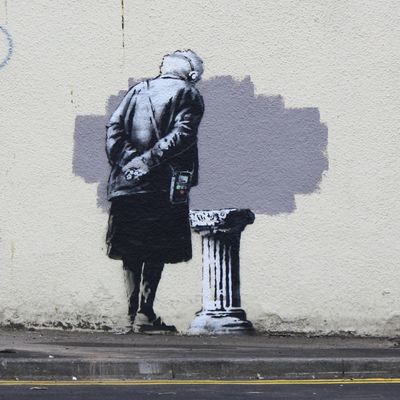
With all of the Champagne, Kim Kardashian sightings, and ÔÇ£curated experiencesÔÇØ to take in at Art Basel Miami Beach this year, one might forget that the whole thing is actually just a trade show. It is more glamorous than, say, the annual cloud-computing fair at the Javits Center, but it is still, at its core, about buying and selling. So how did the dealers who brought a collective $3 billion worth of art to Miami fare this year? Here are a few of the market highlights.
Celebrities were everywhere, and some of them were buying art.
Miley Cyrus twerked at Wayne Coyne. Diddy punched Drake. Leonardo DiCaprio went home with 20 models. This was the celebrity gossip we heard, but several outlets reported that DiCaprio was also there to shop, buying a 1973 Frank Stella painting at Marianne Boesky for just under $1 million. The hard-partying star has been collecting art for several years now, and today owns works by Takashi Murakami, Mark Ryden, and Ed Ruscha, among others. Diddy, meanwhile, was apparently too slow to score a 1918 Pablo Picasso fresco, which Galerie Gmurzynska had already sold to an American collector for around $1 million by the time the hip-hop mogul inquired.
Works on paper are no longer affordable afterthoughts.
At a moment when MoMAÔÇÖs show of Henri Matisse cutouts is among the most popular in the city, and as the Whitney pledges to do away with media-divided galleries when it reopens this spring, it makes sense that dealers reported strong sales on once devalued paper-based works. Dominique Levy sold a swirly blue bouquet on paper by Christopher Wool for $1.5 million, while Skarstedt Gallery sold a paper work by Sigmar Polke for $1 million. Whitney chief curator Donna de Salvo told The Art Newspaper that artists are largely responsible for the trend: ÔÇ£Artists have always been attracted to the materiality of works on paper.ÔÇØ
Megacollectors hit up the satellite fairs too.
On the heels of a Roberta Smith rave in October, the less-than-one-year-old Lower East Side gallery Kai Matsumiya sold a blue block-printed Lucky DeBellevue canvas dotted with pistachio shells for $7,500 to one of the Rubells at NADA, while a friend of the family purchased another work by the artist for $10,000. Down the beach at the Untitled fair, Fredericks & Freiser gallery sold two David Humphrey paintings for $25,000 each to the English collector and early YBA champion Charles Saatchi.
The ÔÇ£Museum EffectÔÇØ was in full effect.
A big museum show almost always boosts an artistÔÇÖs prices. And although the Brazilian artist Beatriz Milhazes doesnÔÇÖt need much help ÔÇö she has sold at auction for well into the seven figures ÔÇö her work was on wide view throughout the week, perhaps partly owing to her first major North American exhibition at the P├®rez Art Museum Miami, through January 11. James Cohan was offering one of MilhazesÔÇÖs brightly colored floral prints at the fair and S├úo PauloÔÇÖs Galeria Fortes Vila├ºaÔÇÖs reported selling a work for $100,000. Meanwhile, Glenn Ligon, who is the subject of a show at LondonÔÇÖs Camden Arts Centre through January 11, offered a line of beach towels, sponsored by the Art Production Fund, for $95 apiece, while Los AngelesÔÇÖs Regen Projects quickly sold one of the artistÔÇÖs silkscreens on canvas for $200,000.
The multi-million-dollar masters are as in-demand as ever.
Even though the gallerist Helly Nahmad was serving out his illegal-gambling sentence at a halfway house in the Bronx, his dealer father attended the fair in his place to sell what was probably the most expensive work there: Alexander CalderÔÇÖs massive $35 million mobile ÔÇö which has more than tripled in price in the last two years. Many other blue-chip standbys could be found elsewhere at the fair. Christophe Van de Weghe sold a Jean-Michel Basquiat painting for $5.5 million, Galerie Gmurzynska ┬ásold two Robert Indiana paintings for $1.7 million each, and Mnuchin Gallery sold an Andy Warhol Mao┬áfor $4.5 million and a John Chamberlain sculpture for $3 million, among others. Yet these prices may well have been trumped by contemporary market kings like Jeff Koons and Takashi Murakami. The latter had one of his grinning-flower paintings on view at PerrotinÔÇÖs booth, while Koons showed a granite sculpture of a bathing woman at Gagosian, but, as usual, the dealer kept mum on the price.
ItÔÇÖs still hard to sell a ÔÇ£stolenÔÇØ Banksy.
Even though Banksy and his fans have repeatedly chastised the New York dealer Stephan Keszler for buying and selling the artistÔÇÖs street murals ÔÇö a process that involves paying locals to excavate the walls and, in turn, removes the works from their intended context ÔÇö Keszler has proved relentless. At Fine Art Auctions Miami during Art Basel, the dealer offered three salvaged Banksy murals, but only one found a buyer. That work, Kissing Coppers,┬áwhich was taken from the side of a bar in Brighton and also appeared at Art Miami in 2012, fetched $575,000. The other works, painted during the artistÔÇÖs New York ÔÇ£residencyÔÇØ last year, failed to sell at price tags of $400,000 to $600,000 (for Bandaged Heart Balloon) and $200,000 to $300,000 (Crazy Horse Car Door). In February, the auction house withdrew another of KeszlerÔÇÖs Banksys, Slave Labor, after protests erupted in London over its removal.


